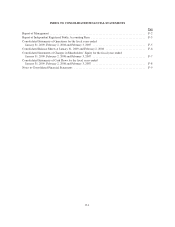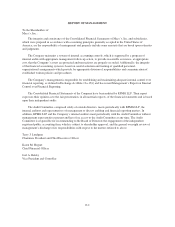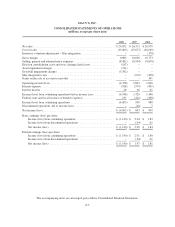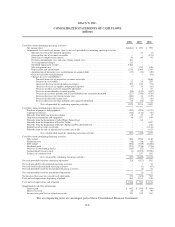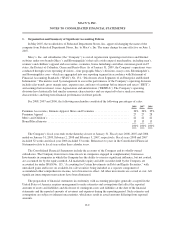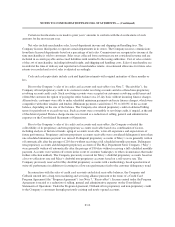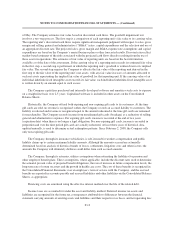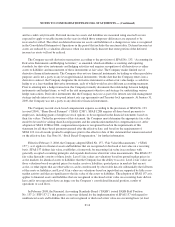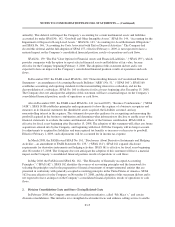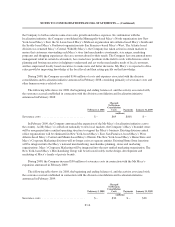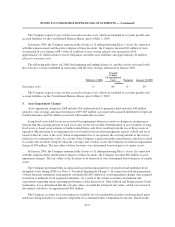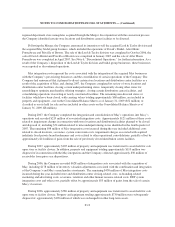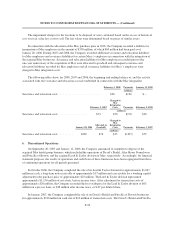Macy's 2008 Annual Report Download - page 59
Download and view the complete annual report
Please find page 59 of the 2008 Macy's annual report below. You can navigate through the pages in the report by either clicking on the pages listed below, or by using the keyword search tool below to find specific information within the annual report.
NOTES TO CONSOLIDATED FINANCIAL STATEMENTS — (Continued)
The Company maintains customer loyalty programs in which customers are awarded certificates based on
their spending. Upon reaching certain levels of qualified spending, customers automatically receive certificates to
apply toward future purchases. The Company expenses the estimated net amount of the certificates that will be
earned and redeemed as the certificates are earned.
Merchandise inventories are valued at lower of cost or market using the last-in, first-out (LIFO) retail
inventory method. Under the retail inventory method, inventory is segregated into departments of merchandise
having similar characteristics, and is stated at its current retail selling value. Inventory retail values are converted
to a cost basis by applying specific average cost factors for each merchandise department. Cost factors represent
the average cost-to-retail ratio for each merchandise department based on beginning inventory and the fiscal year
purchase activity. The retail inventory method inherently requires management judgments and estimates, such as
the amount and timing of permanent markdowns to clear unproductive or slow-moving inventory, which may
impact the ending inventory valuation as well as gross margins.
Permanent markdowns designated for clearance activity are recorded when the utility of the inventory has
diminished. Factors considered in the determination of permanent markdowns include current and anticipated
demand, customer preferences, age of the merchandise and fashion trends. When a decision is made to
permanently mark down merchandise, the resulting gross margin reduction is recognized in the period the
markdown is recorded.
Physical inventories are generally taken within each merchandise department annually, and inventory
records are adjusted accordingly, resulting in the recording of actual shrinkage. While it is not possible to
quantify the impact from each cause of shrinkage, the Company has loss prevention programs and policies that
are intended to minimize shrinkage. Physical inventories are taken at all store locations for substantially all
merchandise categories approximately two weeks before the end of the fiscal year. Shrinkage is estimated as a
percentage of sales at interim periods and for this approximate two-week period, based on historical shrinkage
rates.
The Company receives certain allowances from various vendors in support of the merchandise it purchases
for resale. The Company receives certain allowances as reimbursement for markdowns taken and/or to support
the gross margins earned in connection with the sales of merchandise. These allowances are generally credited to
cost of sales at the time the merchandise is sold in accordance with Emerging Issues Task Force (“EITF”) Issue
No. 02-16, “Accounting by a Customer (Including a Reseller) for Certain Consideration Received from a
Vendor.” The Company also receives advertising allowances from more than 1,000 of its merchandise vendors
pursuant to cooperative advertising programs, with some vendors participating in multiple programs. These
allowances represent reimbursements by vendors of costs incurred by the Company to promote the vendors’
merchandise and are netted against advertising and promotional costs when the related costs are incurred in
accordance with EITF Issue No. 02-16. Advertising allowances in excess of costs incurred are recorded as a
reduction of merchandise costs.
Advertising and promotional costs, net of cooperative advertising allowances, amounted to $1,239 million
for 2008, $1,194 million for 2007, and $1,171 million for 2006. Cooperative advertising allowances that offset
advertising and promotional costs were approximately $372 million for 2008, $431 million for 2007, and $517
million for 2006. Department store non-direct response advertising and promotional costs are expensed either as
incurred or the first time the advertising occurs. Direct response advertising and promotional costs are deferred
and expensed over the period during which the sales are expected to occur, generally one to four months.
F-11


